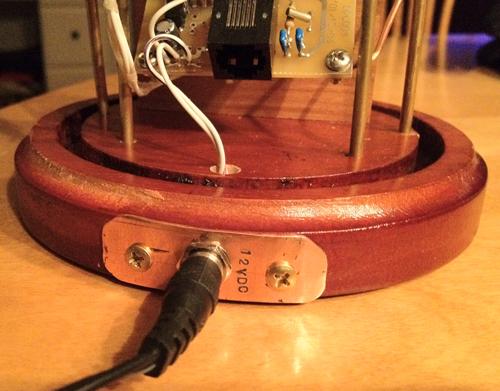David Christianson's inline clock has an electromechanical incandescent display based on an array of tiny projectors that share a ground glass rear projection plane.
February 21, 2013
Lots of clocks make use of Nixie Tube displays, but a much rarer type of display exists. It's an electromechanical incandescent display based on an array of tiny projectors, all sharing a ground glass rear projection plane.
The displays make use of a small piece of film and 12 lens systems to project whatever of 12 images you want to provide. In this case, the displays show the digits zero through nine and lefthand and righthand decimal points.

Clock power entry.
In the 1960s, these displays would cost more than $100 per digit. Since the cost and size of these displays would have made building a clock with four or six digits prohibitive, I chose to make a single-digit display. In an added twist, I used a mechanical relay to sound out the hours and mark the quarter hours with variable-length clicks for quarter, half, and three-quarters past the hour.
Mechanically, the clock was assembled under a craft store display dome. The esthetic is inspired by steampunk, with as much use of wood, copper, and brass as the budget allowed.
The processor and drive electronics reside on a generic PIC16F88 processor prototyping board with the clock-specific hardware, point to point wired in the bread boarding area. The switches and displays are harnessed to this, and the wiring harness is bound with wire lacing cord the old-fashioned way.

David Christianson's inline clock has an electromechanical incandescent display based on an array
of tiny projectors sharing a ground glass rear projection plane.
An AC adapter provides 12V to the circuit. The display and chime relay are powered directly from this bus. The voltage regulator U1 drops this 12V to 5V to power the processor. The processor is configured with a six-pin modular jack to facilitate in-circuit programming and debugging. The processor is clocked at 32.768kHz to make time keeping simple.
Transistor amplifiers provide the power and voltage gain from the digital logic signal from the processor to the levels necessary to power the incandescent bulbs in the inline display. The digits of the inline display are illuminated one at a time by powering the incandescent bulb for that digit.
Setting the clock required a little ingenuity, because the processor had only a single pin available. This was accomplished with a little code that detects whether the switch is connected to VCC or to GND, to advance hours or minutes.
Do you have a Gadget Freak project you would like the world to see? Send a brief description of your gadget and a photo to Senior Editor Rob Spiegel.
{table 1}{table 2}{videoembed|259197}
The editors of Design News have handpicked your favorite Gadget Freak cases from over the years, bringing them together in a dynamic digital edition, complete with videos, which you can view here.
You May Also Like



